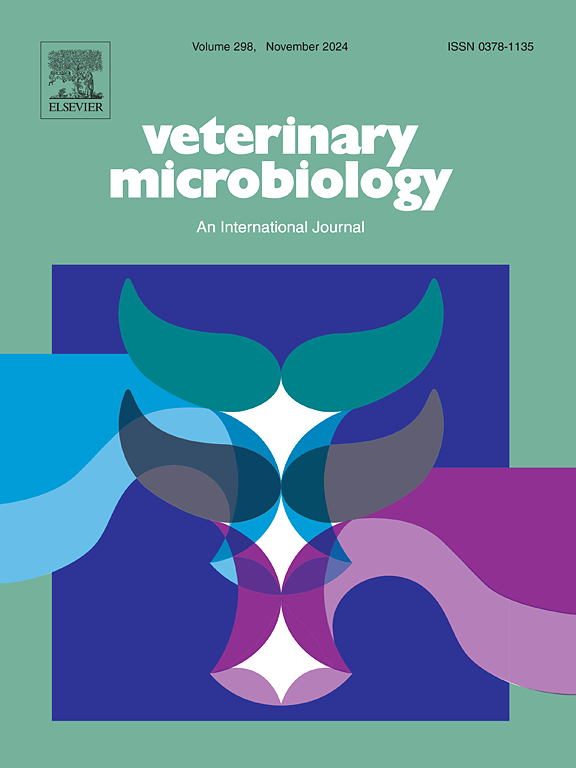Phylogenomics of Brucella abortus isolated from African Buffalo in Kruger National Park: New perspectives on wildlife-cattle disease dynamics
IF 2.4
2区 农林科学
Q3 MICROBIOLOGY
引用次数: 0
Abstract
In South Africa, Brucella abortus biovar 1 is the primary cause of bovine brucellosis, significantly impacting cattle production and trade. Serological studies have revealed brucellosis in African wildlife, complicating control efforts due to limited epidemiological data. In 1977, B. abortus biovar 1 was isolated from an African buffalo fetus in Kruger National Park (KNP), raising speculation that buffalo may serve as reservoir hosts. This study investigated Brucella spp. in free-ranging buffalo in KNP using serological, molecular, and bacteriological methods. Brucella abortus bv 1 was isolated from lymph nodes and spleens of three sub-adult buffalo in 2022, marking the first documented recurrence in 50 years. Phylogenomic analyses revealed connections between buffalo isolates and cattle strains from South Africa and South America, suggesting spillover and shared origins from Europe. Further genomic and epidemiological surveillance is required to clarify the role of buffalo as reservoir hosts for brucellosis.
克鲁格国家公园非洲水牛分离的流产布鲁氏菌系统基因组学:野生动物-牛疾病动力学的新视角
在南非,流产布鲁氏菌生物变种1是牛布鲁氏菌病的主要病因,严重影响牛生产和贸易。血清学研究显示,非洲野生动物中存在布鲁氏菌病,由于流行病学数据有限,使控制工作复杂化。1977年,从克鲁格国家公园(KNP)的非洲水牛胎儿中分离出了流产芽孢杆菌1号生物变种,这引起了水牛可能作为水库宿主的猜测。本研究采用血清学、分子学和细菌学方法对KNP自由放养水牛中的布鲁氏菌进行了调查。2022年,从三只亚成年水牛的淋巴结和脾脏中分离出流产布鲁氏菌bv 1,这是50年来首次有记录的复发。系统基因组学分析显示,来自南非和南美洲的水牛分离株与牛株之间存在联系,这表明了溢出效应和来自欧洲的共同起源。需要进一步进行基因组和流行病学监测,以阐明水牛作为布鲁氏菌病宿主的作用。
本文章由计算机程序翻译,如有差异,请以英文原文为准。
求助全文
约1分钟内获得全文
求助全文
来源期刊

Veterinary microbiology
农林科学-兽医学
CiteScore
5.90
自引率
6.10%
发文量
221
审稿时长
52 days
期刊介绍:
Veterinary Microbiology is concerned with microbial (bacterial, fungal, viral) diseases of domesticated vertebrate animals (livestock, companion animals, fur-bearing animals, game, poultry, fish) that supply food, other useful products or companionship. In addition, Microbial diseases of wild animals living in captivity, or as members of the feral fauna will also be considered if the infections are of interest because of their interrelation with humans (zoonoses) and/or domestic animals. Studies of antimicrobial resistance are also included, provided that the results represent a substantial advance in knowledge. Authors are strongly encouraged to read - prior to submission - the Editorials (''Scope or cope'' and ''Scope or cope II'') published previously in the journal. The Editors reserve the right to suggest submission to another journal for those papers which they feel would be more appropriate for consideration by that journal.
Original research papers of high quality and novelty on aspects of control, host response, molecular biology, pathogenesis, prevention, and treatment of microbial diseases of animals are published. Papers dealing primarily with immunology, epidemiology, molecular biology and antiviral or microbial agents will only be considered if they demonstrate a clear impact on a disease. Papers focusing solely on diagnostic techniques (such as another PCR protocol or ELISA) will not be published - focus should be on a microorganism and not on a particular technique. Papers only reporting microbial sequences, transcriptomics data, or proteomics data will not be considered unless the results represent a substantial advance in knowledge.
Drug trial papers will be considered if they have general application or significance. Papers on the identification of microorganisms will also be considered, but detailed taxonomic studies do not fall within the scope of the journal. Case reports will not be published, unless they have general application or contain novel aspects. Papers of geographically limited interest, which repeat what had been established elsewhere will not be considered. The readership of the journal is global.
 求助内容:
求助内容: 应助结果提醒方式:
应助结果提醒方式:


